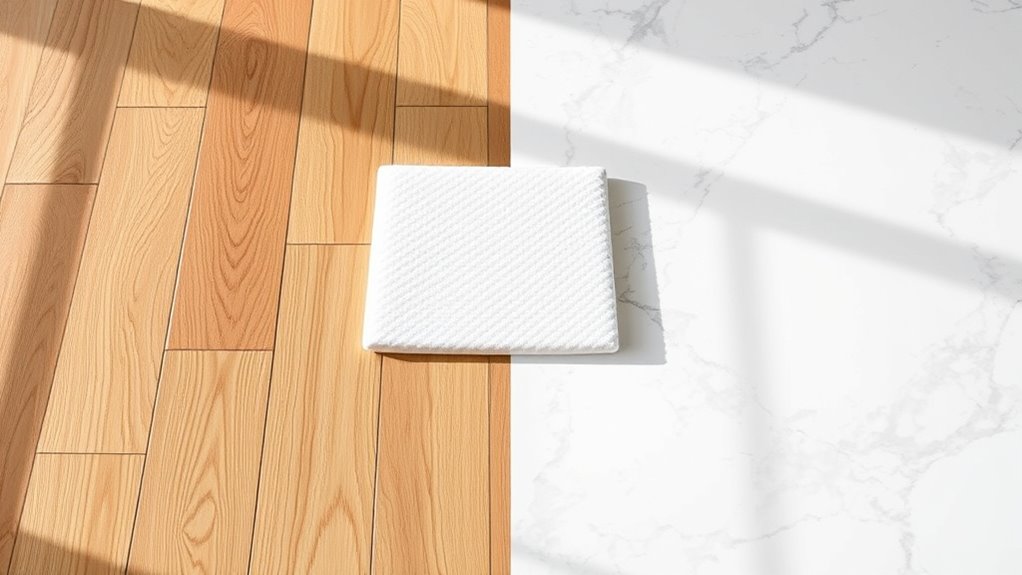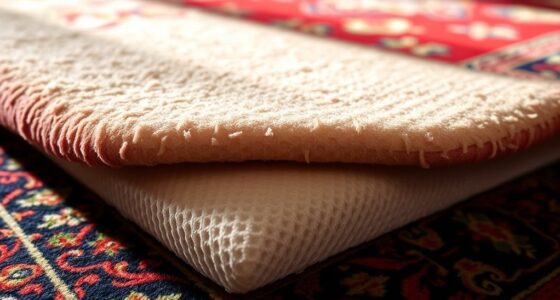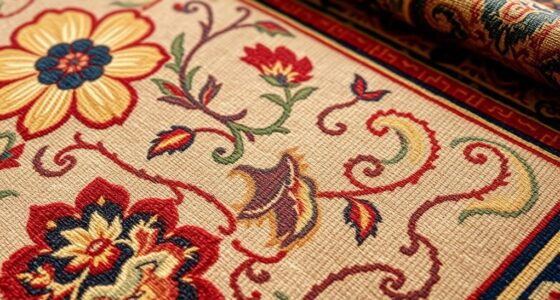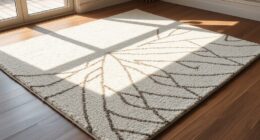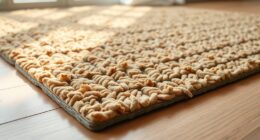When choosing an underlay for hardwood or marble, consider their material properties. Hardwood needs cushioning and moisture barriers to prevent expansion, while marble requires stable support and impact dampening. Sound insulation is essential, especially for hardwood, and thicker or specialized underlays can help with marble noise reduction. Moisture barriers protect both surfaces from damage. Keep in mind the environment and your budget to pick the best fit — there’s more to think about for peak performance.
Key Takeaways
- Hardwood underlays should provide cushioning, moisture control, and sound insulation due to its flexible, expanding nature.
- Marble requires stable, rigid underlays that prevent shifting and support its dense, minimal-expansion properties.
- Use moisture barriers under hardwood to prevent vapor damage, while for marble, focus on impact damping and stability.
- Thicker, impact-resistant underlays benefit marble to minimize noise and protect the rigid surface.
- Select eco-friendly, durable underlays tailored to flooring type, environment, and budget for optimal performance.
Understanding the Role of Underlay in Flooring Performance
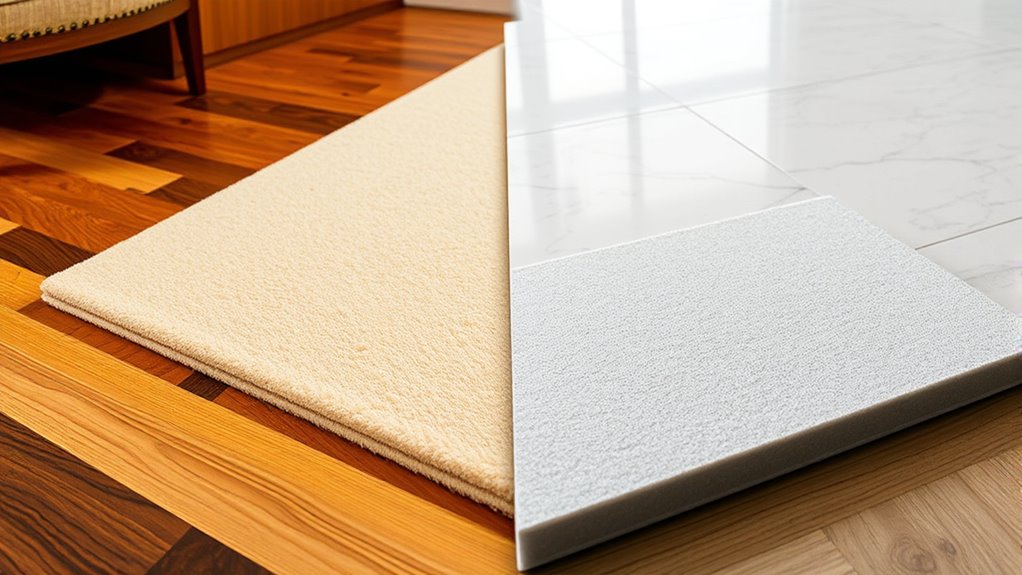
Underlay plays a essential role in flooring performance because it directly affects comfort, durability, and sound insulation. When you choose the right underlay, you enhance your floor’s ability to absorb impact and reduce noise, making your space more comfortable. It also protects your flooring from moisture, shifting, and uneven subfloor surfaces that could cause damage over time. Proper underlay acts as a cushion, providing stability and prolonging the lifespan of your hardwood or marble surface. Additionally, it improves insulation, helping to maintain consistent indoor temperatures. Choosing the correct underlay can also help mitigate issues caused by UV radiation exposure, which can affect the longevity and appearance of your flooring over time. By selecting the appropriate underlay, you guarantee your flooring performs at its best, offering comfort underfoot and reducing disturbances from foot traffic or external noise. It’s a key component that directly influences the overall quality and longevity of your flooring.
Material Properties: Hardwood vs. Marble and Their Underlay Needs
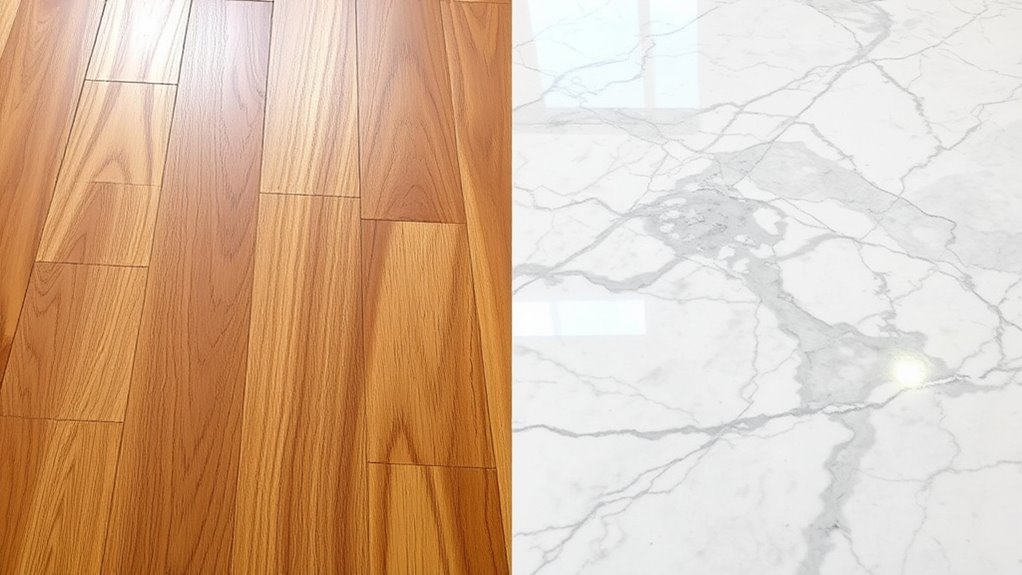
Hardwood and marble flooring have distinct material properties that influence their underlay requirements considerably. Hardwood is softer, flexible, and prone to expansion and contraction with humidity changes. This makes it essential to use underlays that provide cushioning and moisture regulation, preventing uneven settling or squeaking. Conversely, marble is dense, rigid, and highly durable, with minimal expansion. It requires a stable, supportive underlay that prevents shifting and provides a level surface for installation. Because marble doesn’t absorb moisture easily, underlays with moisture barriers aren’t always necessary but can add extra protection. Additionally, selecting an underlay that offers adequate support can help distribute weight evenly and protect against cracking. Understanding these differences helps you select an underlay that enhances each material’s performance, maintains its beauty, and extends its lifespan. Tailoring your choice ensures your flooring remains stable, comfortable, and visually appealing over time.
Sound Insulation and Impact Absorption for Different Floor Types
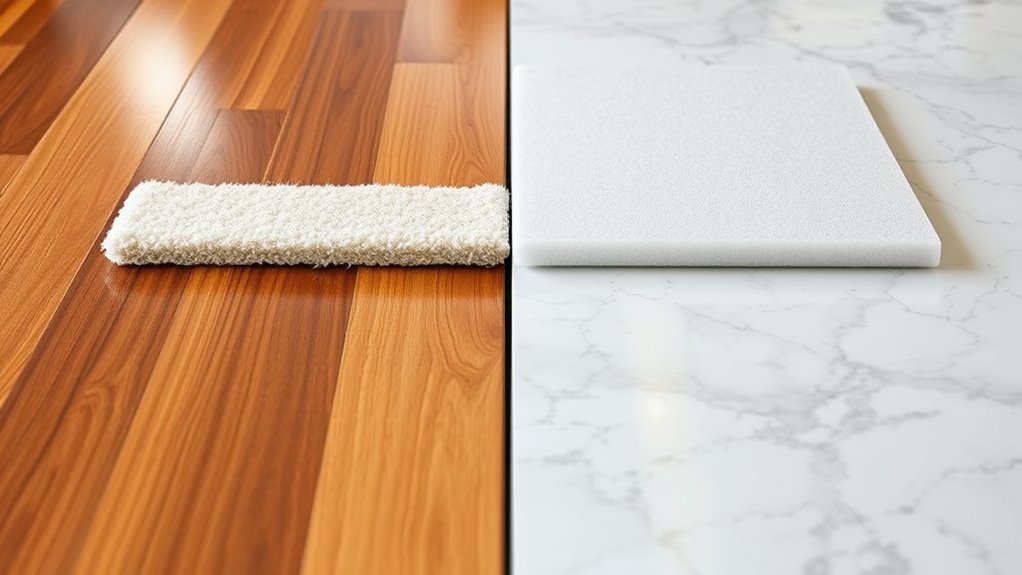
When choosing underlayments for different flooring types, considering sound insulation and impact absorption is essential to create a comfortable and quiet environment. For hardwood floors, opt for underlays with high soundproofing qualities to reduce noise transmission between rooms. They also absorb impact, minimizing creaking and footstep sounds. Marble floors, being harder and more reflective, require thicker or specialized underlays to dampen impact noise and prevent sound reverberation. Using appropriate underlayments helps you enjoy quieter living spaces and protects against noise complaints. Impact absorption is especially important in multi-story buildings or apartments. Select underlays designed for impact resistance, which also help cushion floors and improve overall comfort. Tailoring your choice based on floor type ensures effective sound insulation and a more peaceful home. Additionally, choosing underlayments with appropriate material properties can enhance durability and long-term performance.
Moisture Barriers and Stability Considerations
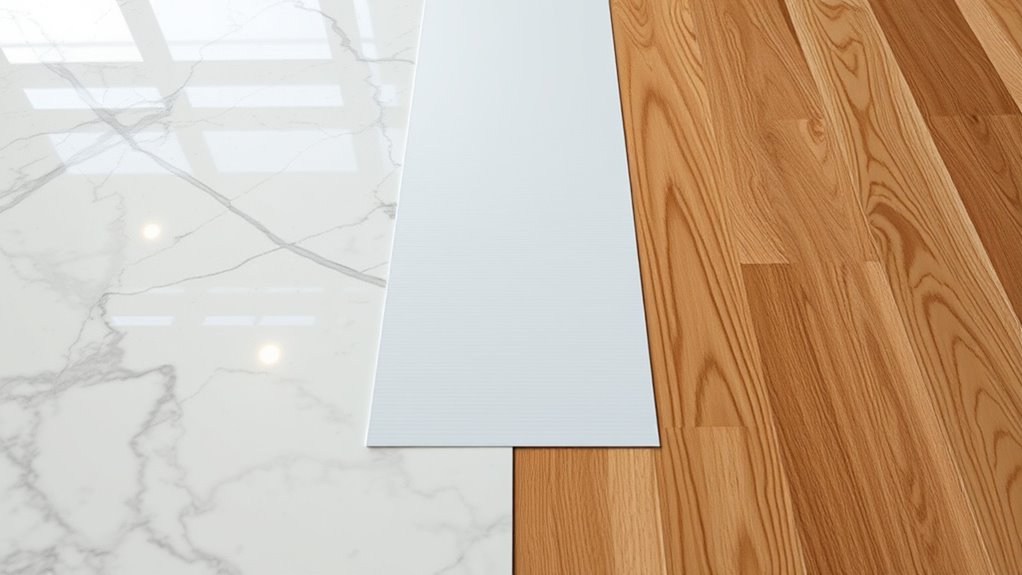
Choosing the right underlayments not only impacts sound insulation but also influences moisture control and floor stability. For hardwood, you need a moisture barrier to prevent water vapor from seeping up and damaging the wood over time. A vapor barrier, like a polyethylene sheet, helps maintain a stable environment, reducing the risk of warping or cupping. Marble floors, being sensitive to moisture, also require effective barriers to avoid staining or damage from moisture absorption. Stability is equally important; an underlay that provides a firm, even foundation helps prevent shifting or uneven surfaces, which could cause cracks or damage. Make sure your chosen underlay offers both moisture resistance and a solid base to support your flooring’s longevity and structural integrity. Incorporating energy-efficient designs into your underlay can further enhance sustainability and reduce long-term costs.
Selecting the Right Underlay: Practical Tips and Recommendations
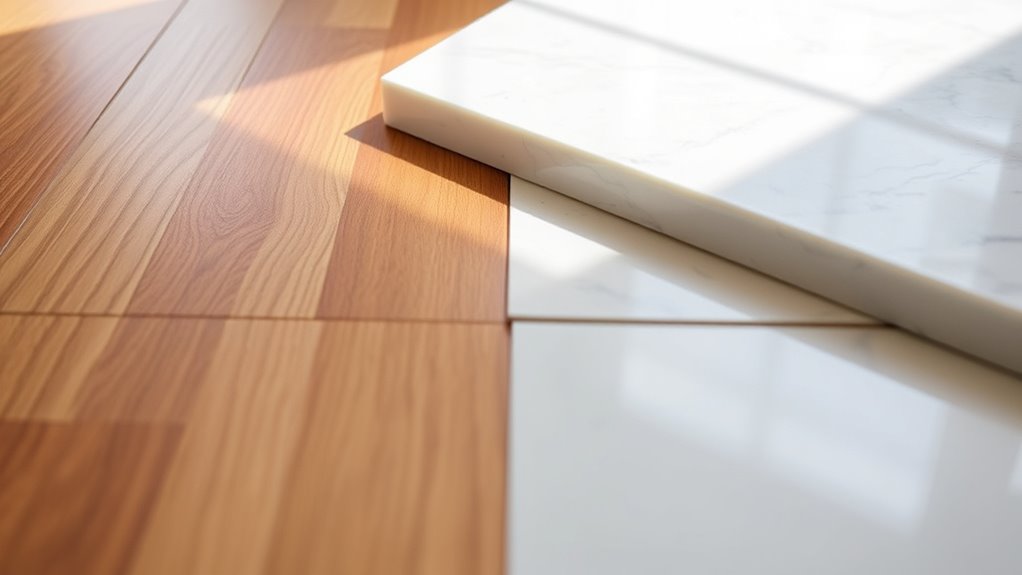
Selecting the right underlay involves understanding your flooring type, usage environment, and budget. To make an informed choice, consider these practical tips:
- Identify whether you need soundproofing or insulation
- Match underlay thickness to flooring flexibility
- Prioritize moisture barriers for basements or humid areas
- Choose eco-friendly materials if sustainability matters
- Assess cost versus long-term durability and comfort
- Explore options for virtual collaboration, which can be useful for remote installation consultations or expert advice.
Frequently Asked Questions
How Does Underlay Affect the Longevity of Hardwood and Marble Floors?
You might wonder how underlay impacts your floors’ lifespan. Using the right underlay helps absorb shocks, reduce vibrations, and provide cushioning. For hardwood, it prevents moisture damage and minimizes movement, extending its life. With marble, it protects against cracks and chips from impacts. Proper underlay also stabilizes the surface, reducing wear and tear over time, so your floors stay beautiful and durable longer.
Can Specific Underlay Materials Enhance Thermal Insulation for Both Floor Types?
Imagine a cozy, roaring fire warming your space—now, think about how specific underlay materials can boost thermal insulation. You can choose foam or cork underlays that trap heat effectively, keeping your floors warmer in winter. For both hardwood and marble, these materials act like a thermal blanket, enhancing comfort and reducing energy costs. Selecting the right underlay makes your floors not only beautiful but also more energy-efficient.
Are There Eco-Friendly Underlay Options Suitable for Hardwood or Marble?
You’re wondering if eco-friendly underlay options work for hardwood or marble floors. Luckily, many sustainable materials like cork, recycled rubber, and natural wool suit both surfaces. These options not only reduce environmental impact but also provide good insulation and soundproofing. You can confidently choose eco-friendly underlays, knowing they support sustainability while enhancing your floors’ comfort and performance.
What Maintenance Practices Are Recommended for Underlay Beneath Different Flooring?
Imagine you’re caring for a marble floor with a foam underlay. To keep it in top shape, you should regularly vacuum or sweep to remove dirt that can cause scratches. Avoid excessive moisture, which can damage the underlay and flooring. For hardwood with cork underlay, occasional damp mopping and avoiding water buildup are key. Consistent cleaning and prompt spill cleanup help prolong your floor’s life and maintain its appearance.
How Do Underlay Choices Influence the Resale Value of a Property?
Your choice of underlay can considerably boost your property’s resale value. High-quality, well-chosen underlays improve comfort and soundproofing, making your home more appealing to buyers. When you select the right underlay for your flooring type, it demonstrates good maintenance and attention to detail. This can make your property stand out in the market, helping you sell faster and often at a better price, showing your investment in quality.
Conclusion
Choosing the right underlay means considering your floor’s needs, your space’s conditions, and your comfort. Whether you prioritize soundproofing, stability, or moisture control, selecting the right material makes all the difference. By understanding the roles of underlay, comparing hardwood and marble requirements, and applying practical tips, you’ll guarantee your flooring performs beautifully, lasts longer, and feels just right underfoot. Make informed choices, enhance your space, and enjoy your stunning floors for years to come.
